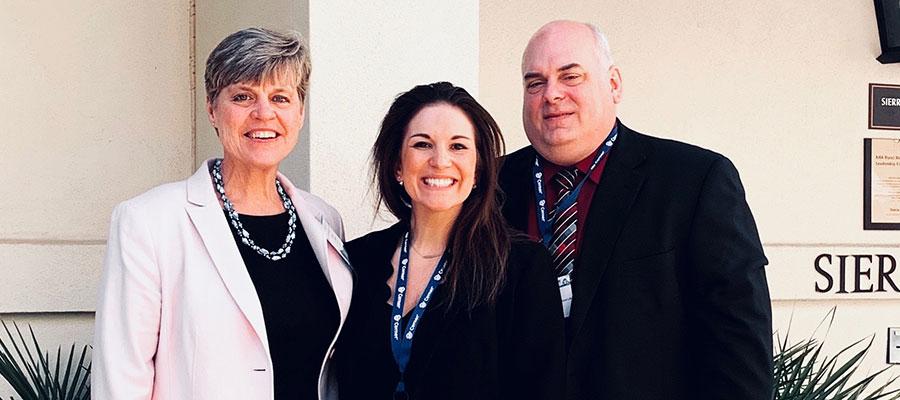How Copley Hospital is decreasing the number of ED visits by connecting its community to care

Leaders at Copley Hospital, Morrisville, Vt., presented last week at AHA’s 2019 Rural Health Care Leadership Conference on the success of their quality improvement project to decrease super-utilizer ED visits and address the high costs of care in their community. The initiative resulted in a potential cost savings to the health care system of almost $180,000.
In efforts to increase primary care use in the community and decrease avoidable emergency department visits, Copley Hospital in Morrisville, Vt., has spent the past few years examining state data to better understand its population’s needs. Copley leaders discovered that the hospital’s catchment area was considered above average in the number of potentially avoidable ED visits while, at the same time, under the state’s average for referrals to primary care doctors.
For several years, the hospital asked all patients at registration if they had a primary care provider and, if they didn’t, offered to share their information with a care coordinator working with all of the medical homes in the area. Despite the good intention, the effort did not reduce avoidable visits.
“We saw that trend going back several years, and it continued to be disproportionate to the rest of the state,” said Michael Brigati, director of emergency services and clinical life safety at Copley Hospital.
Copley then proposed partnering with the federally qualified health center to hire a communal social worker in the ED who would focus on better understanding the community’s population of “high utilizers.”
Copley leaders identified 29 patients to study for a three-month period — those who had four or more potentially avoidable ED visits within a 90-day period.
The initial results were surprising.
“We thought the highest utilizers wouldn’t have insurance or a primary care physician,” Brigati said.
Instead, they found the opposite. Every patient in their pilot group had insurance, with 14 percent having commercial insurance. In addition, they all had a primary care physician.
Tailoring a community initiative to meet patients where they are
Copley’s health care leaders changed their project’s focus. Instead of helping patients get insurance and a designated primary care physician, Copley Hospital began to explore what activities were contributing to high utilization in the ED.
“We realized that maybe we needed to focus a little bit more on social determinants and better understand who our patients in our community are and why are they coming to the ED so much,” said Lori Profota, Copley’s chief nursing officer. “The data can show us one thing, but meeting the patient where they are is really what this work was about.”
Copley leaders tailored their work to address the barriers preventing their patients from getting the care they needed before reaching the ED. By studying the charts of the 29 pilot group patients, they learned that transportation posed one of the biggest barriers to care. The hospital was active in the state’s Blueprint for Health initiative that encouraged collaboration and information sharing between community care coordinators in medical homes, case workers, social service organizations, and local agencies. By sharing this data, community partnerships began to form for enhancing transport services.
Discovering untapped community resources
“We found a lot of community agencies out there were untapped by our ED patients because there wasn’t that one person to coordinate exactly what the patient needed,” Brigati said.
For instance, the Vermont Chronic Care Initiative had a case worker on staff whose job was to manage cases for the Medicaid population.
“The ED really didn’t use that as a resource in our community until we started looking at the percentage of those patients in our initial pilot group of 29 who were on Medicaid,” Brigati said, “so we started referring more of our Medicaid high utilizers to them.”
By working with the case managers, nurses, community health teams, and the FHQC across the street that provides primary care (Copley does not), the hospital identified a clear pathway to the different types of services patients could access. These entities worked within a decentralized care model, and the decision was made to create a shared care plan to better coordinate available services.
Part of that coordinated care plan included the services of the communal social worker in the ED, who would be responsible for following up with patients to ensure they followed through in receiving further care. The social worker also would take responsibility for setting up resources, managing care plans, and ultimately closing the loop to determine whether the patient got the needed services.
Project’s investment leads to reduction in ED visits, hospital cost savings
Copley’s social worker came to the hospital without a medical background or predisposed barriers to how the process was supposed to work, Brigati said. The social worker considered it standard practice to go above and beyond: calling patients back, coordinating medication or transportation, and advocating for them — a major reason the project succeeded, Brigati said.
These “light touches,” of quick check-ins or phone calls to patients to follow up, made a world of difference, Profota said.
Brigati said that in today’s economy, it’s hard to justify adding positions to your already-thin staffing model, “but what this has really proved is the difference one person — or now, we’re up to two people in this role — the difference that a very small amount of people or resources a hospital can put into something that will have really large outcomes.”

